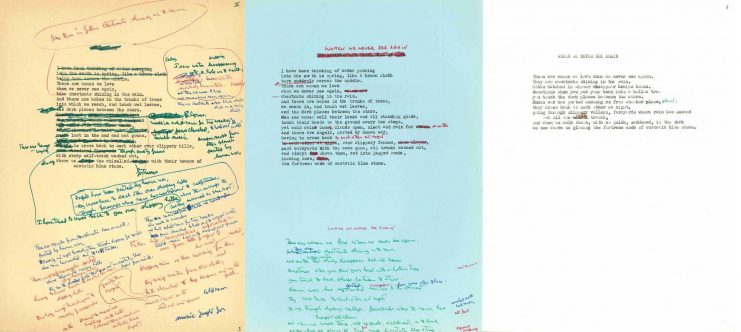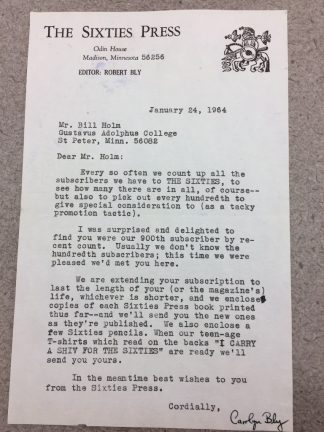By Kathryn Hujda
Assistant Curator, Upper Midwest Literary Archives
From messy handwritten notes to concise editorial markings — from proof to print — poetry in the archives takes many shapes and forms. Numerous drafts illustrate poetic play and practice. Manuscripts and page proofs reflect the editorial process and the role of editors, and publishers. Books, chapbooks, and broadsides celebrate the beauty of the printed word and our lasting desire to hold it in our hands.
For the next 12 months the Upper Midwest Literary Archives will explore the art of poetry through the archives of four pivotal Minnesota poets and one premiere literary press: Robert Bly, Bill Holm, Margaret Hasse, and Milkweed Editions. Our project, Prairie Poets and Press: Literary Lives of the Upper Midwest, will celebrate and make accessible materials that reveal the high quality of Minnesota’s literary production and demonstrate the productive force of literary friendships, both personal and professional.
Staff will be sifting through hundreds of boxes of manuscripts, drafts, correspondence, publications, audio and video recordings, notebooks, journals, press clippings — the stuff of archives — searching for surprises and the ties that bind these like-minded poets and publishers together.

Three drafts of the poem, “Women We Never See Again.” These drafts show extensive edits, not only to the body of the poem, but also several changes of title.
The archives of writers and publishers are sprawling in nature. Such collections can provide evidence of the craft, and often demonstrate the many hours required to take a piece from draft to print.
For, example, the Bly archives are bursting with drafts of individual poems, often in multiple iterations and under heavy revision by the poet himself. His poem, “Women We Never See Again” (pictured here) went through several drafts and rounds of edits. Though originally considered for inclusion in Bly’s first collection, Silence in the Snowy Fields (1962), the poem would not be published in a book-length collection from Bly until 1979. The existence of such drafts help us understand Bly’s process, his command over language, and the work of word-play.

Letter from Carol Bly, co-editor of The Sixties Press, to Bill Holm, written 1964. Holm was just 21 years old when he became the 900th subscriber to The Sixties Press. This letter is the first of many exchanges shared between Holm and Carol Bly.
Poetry archives also prove that though a solitary art, poetry is dialogic in practice. Drafts shared among colleagues, poems about other poets, and exchanges between the poet and editor are just some of the dialogues occurring behind every poem. And for Bly, Hasse, Holm, and Milkweed, that conversation was constant — each enmeshed in the literary community, playing a role in both shaping and supporting the work of poets and writers in Minnesota for over 50 years.
This shaping dialogue can be seen in the letters from Robert Bly and Carol Bly to Bill Holm (who himself was a young poet when they first met), or those exchanged between Holm and his editors at Milkweed Editions.
Margaret Hasse’s work as an artist, consultant, and educator has brought conversations around poetry to numerous educational, social service, and government agencies locally as well as nationally. Even the Bly poem, with its multiple edits, illustrates the poet in conversation with himself.
These collections contain multitudes, but without proper preservation, arrangement and description of materials, this richness is at risk of being lost or falling to disuse. The Prairie Poets and Press project will uncover the previously unseen, unsung, and surprising aspects of these collections in order to fully celebrate their richness and share it with the world. By removing barriers to access, we can reveal the possibilities hidden within these collections in innovative, and even game-changing ways. Please check back for more updates, and follow us as we explore these collections and carry out this important work.
Funding for Prairie Poets and Press
Prairie Poets and Press has been financed in part with funds provided by the State of Minnesota from the Harts and Cultural Heritage Fund through the Minnesota Historical Society. The Minnesota Historical and Cultural Grants Program has been made possible by the Arts and Cultural Heritage Fund through the vote of Minnesotans on November 4, 2008. The Arts and Cultural Heritage Fund raises millions of dollars each year to support the artists and cultural heritage institutions (such as historical societies, libraries, and museums) that keep our state great, our citizens thoughtful, and our community thriving.




